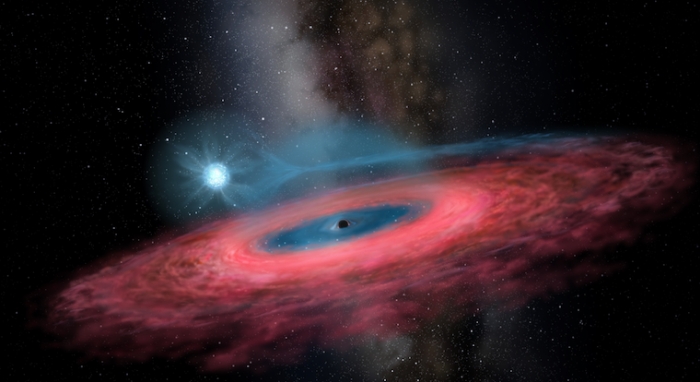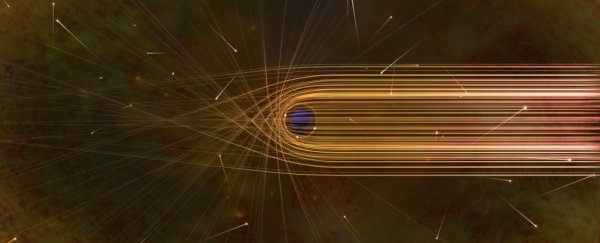A new black hole search method has just yielded fruit, and boy is it juicy. Astronomers have found a stellar-mass black hole clocking in at around 70 times the mass of the Sun - but according to current models of stellar evolution, its size is impossible, at least in the Milky Way.
The chemical composition of our galaxy's most massive stars suggests that they lose most of their mass at the end of their lives through explosions and powerful stellar winds, before the star's core collapses into a black hole.
The hefty stars in the mass range that could produce a black hole are expected to end their lives in what is called a pair-instability supernova that completely obliterates the stellar core. So astronomers are scratching their heads trying to figure out how the black hole - named LB-1 - got so chonky.
" Black holes of such mass should not even exist in our galaxy, according to most of the current models of stellar evolution," said astronomer Jifeng Liu of the National Astronomical Observatory of China.
"LB-1 is twice as massive as what we thought possible. Now theorists will have to take up the challenge of explaining its formation."
The method by which the black hole was detected was really clever.
Black holes, unless they are actively accreting matter, a process that glows in several wavelengths across the spectrum, are literally invisible. They don't give off any radiation we can detect - no light, no radio waves, no X-rays, zip, zilch. But that doesn't mean we have nothing in our detection toolkit.
Way back in 1783, English natural scientist John Michell (the first person to propose the existence of black holes) suggested that black holes may be detectable if they were orbited by something that does emit light - such as a companion star - which would be tugged around the resulting binary system's mutual centre of gravity.
This is now known as the radial velocity method, and it's one of the main ways we search for and confirm the existence of hard-to-see exoplanets as they exert a small gravitational influence on their stars. And it can also be used to find other invisible things - such as black holes.
Liu and his colleagues were using the Large Sky Area Multi-Object Fiber Spectroscopic Telescope (LAMOST) in China to search for these wobbly stars, and got a hit on a main-sequence blue giant star.
But it took follow-up observations using the powerful Gran Telescopio Canarias in Spain and the Keck Observatory in the US to reveal the amazing nature of what the scientists had found.
 Artist's impression of LB-1. (YU Jingchuan, Beijing Planetarium, 2019)
Artist's impression of LB-1. (YU Jingchuan, Beijing Planetarium, 2019)
The star, around 35 million years old and clocking in at around eight times the mass of the Sun, is orbiting the black hole every 79 days on what the researchers called a "surprisingly circular" orbit.
There has been another black hole of a similar mass range detected, clocking in at around 62 solar masses - it was created as a result of a collision between two black holes in a binary pair - GW150914, the first direct detection of gravitational waves ever made by humans. It's not in the Milky Way, but it does offer one way such a black hole can form.
But the newly discovered LB-1 still has its binary companion. One scenario could be that LB-1 formed from the collision of two black holes and then captured the star later - but the circular orbit of its companion causes a problem here. A capture would produce a highly eccentric, elliptical orbit. Time could smooth this orbit out, but it would take longer than the star's age.
One possibility, however, could be a fallback supernova, in which material ejected from the dying star falls immediately back into it, resulting in the direct formation of a black hole. This is theoretically possible under certain conditions, but no direct evidence for it currently exists.
Perhaps LB-1, the researchers noted in their paper, could be this direct evidence.
However it formed, LB-1 has suddenly become one of the most interesting objects in the Milky Way, and a flurry of follow-up observations are likely to ensue.
"This discovery forces us to re-examine our models of how stellar-mass black holes form," said LIGO Director David Reitze of the University of Florida, who was not involved in the research.
"This remarkable result along with the LIGO-Virgo detections of binary black hole collisions during the past four years really points towards a renaissance in our understanding of black hole astrophysics."
The research has been published in Nature.
Editor's note (28 November 2019): An earlier version of this article incorrectly stated that GW150914 is located in the Milky Way. We have amended the error.
